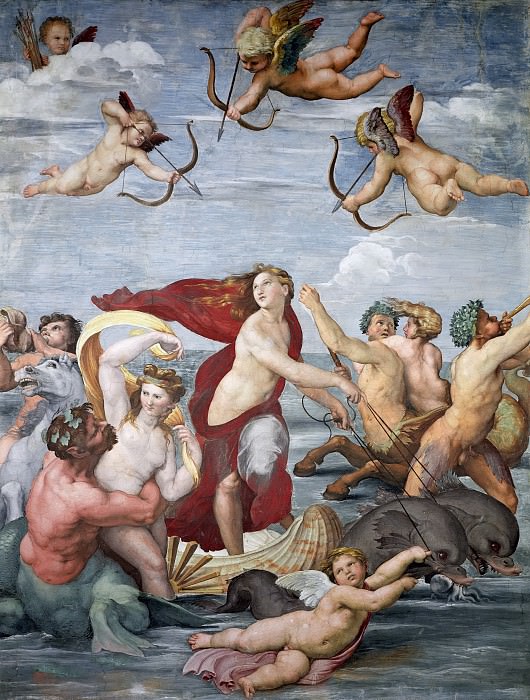Triumph of Galatea Raphael (1483-1520)
Raphael – Triumph of Galatea
Edit attribution
Download full size: 2480×3278 px (2,3 Mb)
Painter: Raphael
Location: Villa Farnesina, Roma.
Raphael Santi is one of Rome’s most famous painters, famous throughout the world for his painting of the Vatican stanzas. The artist’s eclectic approach to his work, as well as his critical mind, attracted the townspeople, and, therefore, he never sat idle. A passionate fan of painting, a certain Agostino Chigi, was not indifferent to the works of Raphael, who ordered one of the most significant works - "The Triumph of Galatea".
Description of Raphael Santi’s painting The Triumph of Galatea
Raphael Santi is one of Rome’s most famous painters, famous throughout the world for his painting of the Vatican stanzas. The artist’s eclectic approach to his work, as well as his critical mind, attracted the townspeople, and, therefore, he never sat idle. A passionate fan of painting, a certain Agostino Chigi, was not indifferent to the works of Raphael, who ordered one of the most significant works - "The Triumph of Galatea". In 1510 Agostino Chigi began the construction of the magnificent palace of Villa Farnesina, which he decorated with splendid luxury. Being familiar with Raphael’s work, Chigi asks the painter to paint the walls inside one of the rooms. It is believed that the inspiration for the painting was taken from the poem "The Triumph of Galatea" by the Greek poet and philosopher Theocritus. Raphael was known to be an ardent admirer of the ancient era. Some details of the painting clearly have similarities with the work of Sandro Botticelli’s The Birth of Venus. As for the modeling technique of the work, it was borrowed from Michelangelo. True, supplemented by Raphael’s own strokes, which did not notice the auto technique. The plot of the painting is both simple and clear: Polyphemus, having lost his mind from jealousy and love for Galatea, who does not share his feelings, kills her lover, burying his body under the rocks. Mad with grief, the girl turned the blood of her beloved into a swift and clear river. And ever since, Galatea has been regarded as the patroness of rivers, seas, oceans and all those who are somehow connected with water. In the painting Galatea is depicted in a chariot in the form of a shell, harnessed by dolphins. This is how Raphael saw the goddess of the sea. To complete the composition, the girl was surrounded by mythical creatures, which set the mood of general jubilation and happiness. The naked bodies are perfectly accentuated by the golden tones, the gently blue sky and the blue sea.
Кому понравилось
Пожалуйста, подождите
На эту операцию может потребоваться несколько секунд.
Информация появится в новом окне,
если открытие новых окон не запрещено в настройках вашего браузера.
You need to login
Для работы с коллекциями – пожалуйста, войдите в аккаунт (open in new window).




















You cannot comment Why?
To her left, a muscular merman embraces a nymph, their forms intertwined with swirling energy. Other figures, including a centaur and a sea creature, propel the chariot forward. Above, cherubic putti, with wings outstretched, aim their bows and arrows towards the heavens, adding a celestial dimension to the scene. One putto holds a bundle of sticks, perhaps a reference to a divine punishment or a magical element. The water is rendered with expressive brushstrokes, conveying the movement and power of the sea.
The subtext of the painting lies in its exploration of love and desire. The multiple putti poised to shoot arrows symbolize Cupids influence, suggesting that love is an irresistible force. Galatea, often associated with unattainable beauty and idealized love, is the central figure in this procession. The painting is interpreted as a celebration of her transcendence over the crude desires of her pursuers, particularly the cyclops Polyphemus, who is sometimes portrayed as a rejected suitor. The triumph is not just over those who desire her, but also over the earthly realm, as the celestial putti suggest a divine approval or involvement in this romantic narrative. Raphael masterfully blends the earthly and divine, the sensual and the spiritual, creating a visual poem on the power and complexities of love.